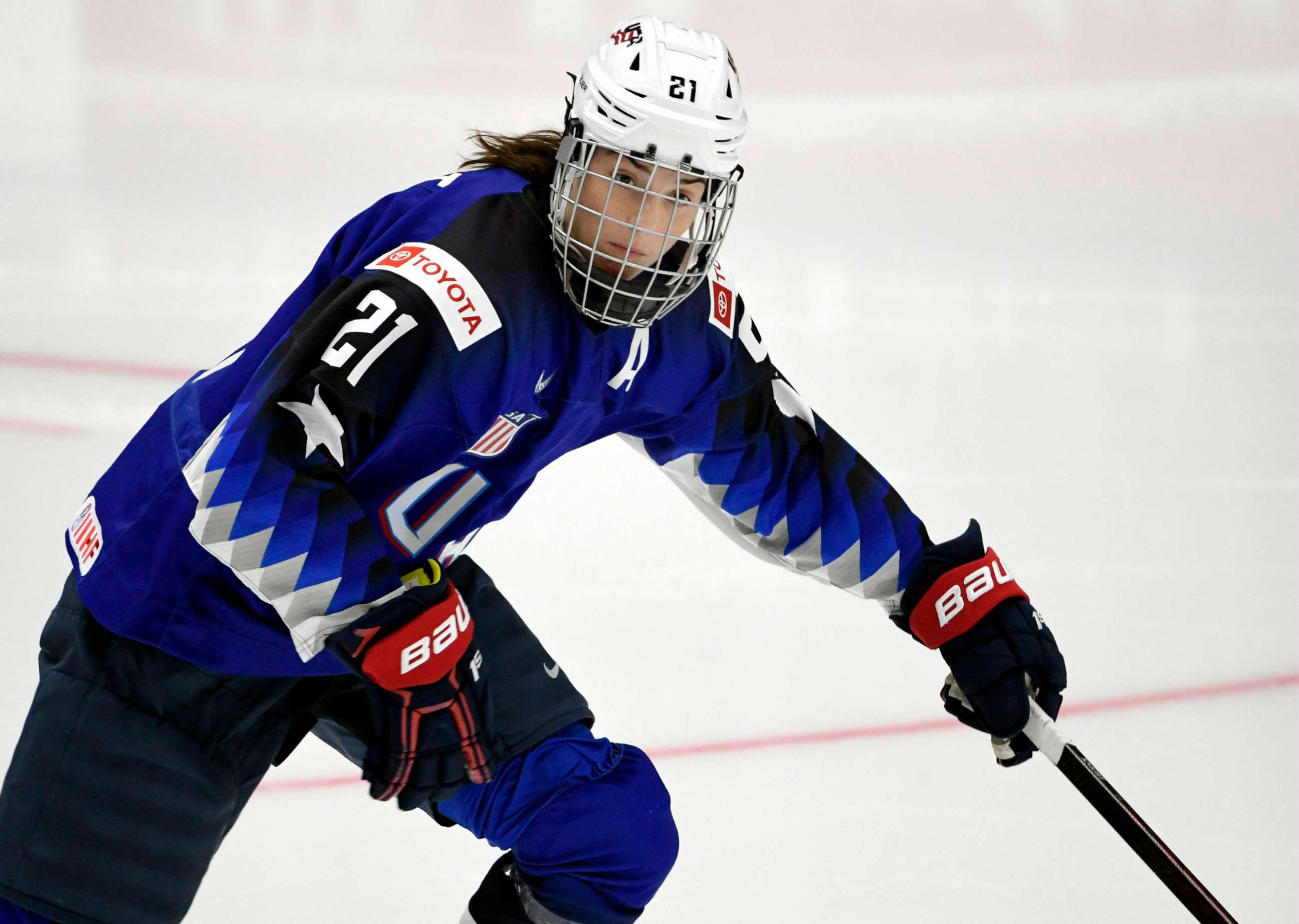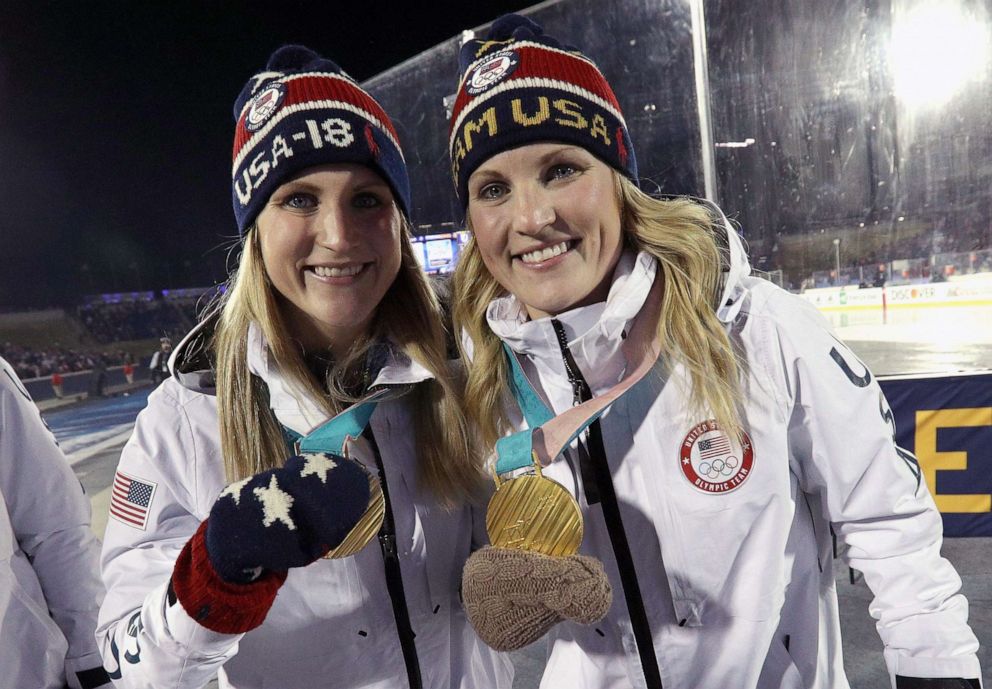US women's hockey players dominate world competitions, but push for 'one league' back home
The next few months are "going to dictate the way women's hockey is seen."
The American hockey team is going into Sunday's Ice Hockey Women's World Championship finals dominating its competition.
In its previous four games, the team scored 30 goals against the other top teams in the world. Its opponents -- Russia, Japan, Switzerland and Russia again in the semifinals -- were shut out and didn't score any goals.
But for all their dominance on the ice, the athletes are still looking for support off it -- to help build the foundation to grow a sustainable North American women's hockey league that will keep interest beyond international competition.
It's really important, the next steps we take in the next few months -- it's going to dictate the way women's hockey is seen in the future.
"Whether you like it or not, you're given a platform to truly make a difference. What's been amazing is that our team has embraced that and really tried to create changes beyond just playing hockey," forward Jocelyne Lamoureux-Davidson, who is not competing in worlds after recently giving birth, told ABC News.
For these athletes, there are three levels of competition: first, there's what happens on the ice; then there's their ongoing efforts to work with USA Hockey, which governs the national team, to increase equity; and finally, there's the players' desire for "one league" -- a professional league of local teams between the United States and Canada that would function like the National Hockey League.

Those calls for "one league" have grown since the end of March, when the Canadian Women's Hockey League (CWHL) announced it was folding. For American forward Hilary Knight, who played in the CWHL and whose professional future is now somewhat in the air, the closure is an opportunity.
"It's really important, the next steps we take in the next few months -- it's going to dictate the way women's hockey is seen in the future," she told ABC News.
Step 1: Equity within USA Hockey
The national hockey team went into the 2018 Olympics hoping a gold medal would be a catalyst for further growth in women's hockey, a year after they threatened a boycott before agreeing to a positive deal with USA Hockey.
In their demands to USA Hockey, the national team players were asking not just for higher wages for themselves, but for the infrastructure for women's and girls' hockey so the sport would grow. They recognize women's hockey is nowhere near as popular as men's, so their goals are, instead, to lay the groundwork for the future.
In some respects, after winning gold at the 2018 Olympics, the team was left frustrated, as reported by The New York Times, with a lack of promotion from USA Hockey.
ABC News reached out to USA Hockey for comment but the league did not respond.
I feel like it's moved slowly, but it's starting to move in the right direction.
Some older players felt "disappointed" that "there was not a whole lot that happened to the team" after a post-Olympics media tour, U.S. defenseman Monique Lamoureux-Morando, Jocelyne's twin, who is also sitting out worlds after recently giving birth, told ABC News.
That lack of promotion was a missed opportunity, players believed, to capitalize on the attention they'd gained at the Olympics.

"But, I think as of late, USA Hockey has been working with the players and the staff and really trying to collaborate and move forward in a positive direction," Lamoureux-Morando said. "I feel like it's moved slowly, but it's starting to move in the right direction."
Knight, too, said the team has "a strong working relationship now with USA Hockey," even if sometimes she does have to "take a deep breath" and remind herself "it's not built overnight."
It helps that they can see the fruits of their efforts. For instance, at this year's world championship in Finland, many of the athletes' families are there. That wasn't always the norm, Knight said.
"We've got families here, because they're [now] provided a ticket and housing. That's a great step, giving a nod to the steps we put together with USA Hockey," she explained.
Step 2: 'One league'
"People watch women's hockey during the Olympics, and then the other three years it's not as visible," Lamoureux-Morando said. "The next biggest thing to take women's hockey to the next level in visibility is to have one sustainable league."
There is a clear concentration of talent in women's hockey in Canada and the United States. As it stands now, though, players from both countries only play against each other during international competition as part of national teams.
Otherwise, the athletes have competed in two separate professional leagues: the CWHL and the National Women’s Hockey League (NWHL) in America, where they play on local teams. Picture the New York Rangers, for example, never playing against the Toronto Maple Leafs.
The players have long been calling for "one league," preferably under the umbrella of the NHL. Last month, ESPN, citing sources, reported that the NHL would be interested if the CWHL and NWHL either merged or both folded.
Since the CWHL folded, the NHL said in a statement to ABC News, "The NHL's position has been consistent for some time and remains unchanged with this news: We would consider starting a women's league if there were no alternatives for women to play professionally in North America."
It's a daunting task, for sure, but we're builders, we're visionaries, and we can get it done if we want to.
"As long as elite women hockey players have professional opportunities, it is not an environment we are prepared to wade into in any formal way," NHL deputy commissioner Bill Daly said. "We have always supported professional women's hockey, and we plan to continue to do so. That doesn't mean we need to form or directly subsidize an existing professional league."
ESPN reported the NHL agreed to "significantly" increase its financial support of the NWHL since the closure, with sources saying it will contribute $100,000.
But the women have no plans of backing down on their calls for a unified North American professional league.
"At some points it's like, 'Oh my gosh, it's sort of all on our shoulders,' but we have a lot of brilliant women working together and we're going to accomplish some big things," Knight said. "We're going to dictate the next direction and the next iteration of professional hockey, which is really exciting. It's a daunting task, for sure, but we're builders, we're visionaries, and we can get it done if we want to."
Step 3: Keep up the motivation
The hockey players are far from the only female athletes making public fights for gender equity, and they see them as intersecting battles -- Knight said she would tell the U.S. women's soccer team "thank you" for their work.
"We're all in it together even though we're playing different sports," Knight said. "It's for something bigger, and we're trying to change the world and using sports as a vehicle to do it."
Women's hockey is "about a generation behind women's basketball," Lamoureux-Morando said, and they use that as a sort of benchmark. The WNBA has existed under the NBA's umbrella for more than 20 years now, and while it's still working at reaching popularity levels of the men's league, it has been steadily growing in popularity and esteem.
"I think women’s hockey can follow in those footsteps, if it’s done the right way," she said.

For the Lamoureux twins, who were instrumental in last year's gold medal, the concept of building for the future became more real as they both gave birth to sons in the past few months.
They both said being moms has not changed their perspective on the need to level the playing field, but, as they return to training, "it gives us a new motivation to get back on the national team," Lamoureux-Davidson said.
"What better example to show your kids that they can do anything they set their minds to than by actually showing them yourself?" Lamoureux-Morando said. "When we lace up our skates for the last time and we're retired and done, I think we can honestly say that not just us, all of our teammates have truly left the Team USA jersey in a better place.
"If we can tell that story to our kids," she continued, "then I think we've done a good job."




